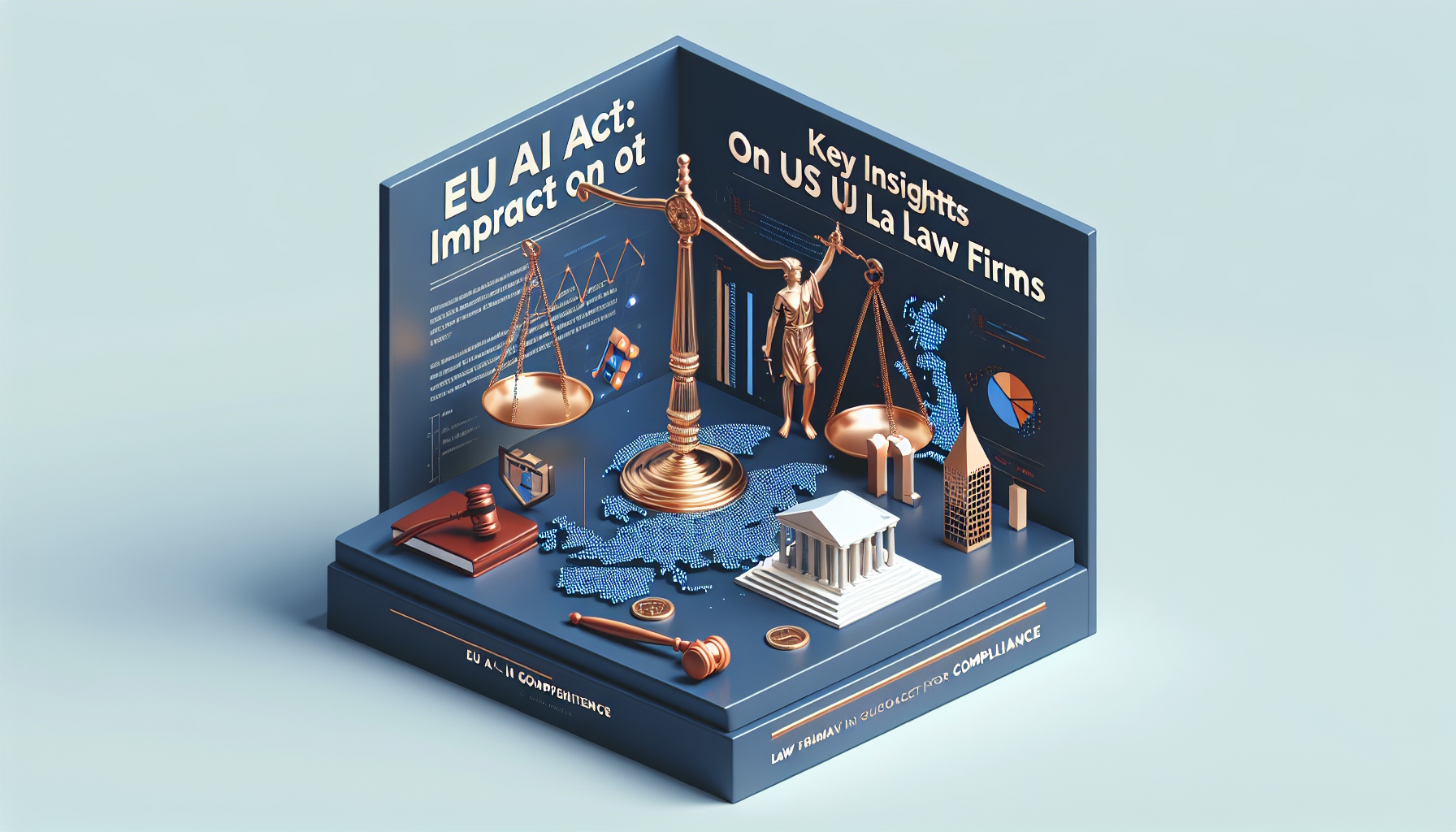EU AI Act Impact on U.S. Law Firms: What You Need to Know Now
Artificial intelligence is rapidly changing how legal services are delivered, from contract review to litigation strategy. While most U.S. firms focus on domestic ethics rules and privacy laws, the European Union’s AI Act introduces a comprehensive, risk-based regime that will shape how U.S. law firms build, buy, and deploy AI—especially when representing EU clients or handling matters that touch the EU.
Note: This article provides practical guidance for legal professionals and does not constitute legal advice. Always consult the final text of the EU AI Act and competent authority guidance before making compliance decisions.
Table of Contents
- Why the EU AI Act Matters to U.S. Law Firms
- Key Opportunities and Risks
- Best Practices for Implementation
- Technology Solutions & Tools
- Compliance Timeline and Planning
- Industry Trends and Future Outlook
- Conclusion and Call to Action
Why the EU AI Act Matters to U.S. Law Firms
The EU AI Act is the world’s most comprehensive horizontal AI regulation. It applies extraterritorially and uses a risk-based approach, imposing stricter duties for higher-risk AI systems. For U.S. law firms, its relevance is not theoretical—many will be “deployers” of AI systems in EU matters, and some will be “providers” if they build or customize tools for clients.
Who Is in Scope? Roles and Reach
| Role (under the AI Act) | How a U.S. Law Firm Might Fit | Why It Matters |
|---|---|---|
| Provider | Your firm develops or substantially modifies an AI system and places it on the EU market (e.g., a custom contract-review model offered to clients). | Heavier obligations: conformity assessment, technical documentation, transparency, risk management, post-market monitoring. |
| Deployer | Your firm uses AI in the course of providing services in the EU or affecting people in the EU (eDiscovery, research, client intake triage). | Duties around human oversight, usage policies, record-keeping, instructions for use, and certain risk/impact assessments. |
| Importer/Distributor | Your firm resells or introduces a third-party AI tool into the EU market. | Verification and documentation duties; ensuring compliance of the tool you introduce. |
The Act can apply to non-EU organizations whose AI outputs are used in the EU. If your firm advises EU clients, manages cross-border litigation, conducts investigations touching EU data subjects, or operates an EU office, you should assume some level of applicability.
Risk Classes and Legal-Industry Examples
- Prohibited practices (e.g., certain manipulative or biometric systems). These are unlikely to be central to legal practice but can arise in investigations or vendor tools.
- High-risk systems (e.g., AI used in hiring, critical services, or in some law-enforcement contexts). Firm uses of AI in HR or regulated sectors can trigger high-risk obligations.
- Limited risk (transparency duties), such as chatbots that must disclose they are AI.
- Minimal risk (most productivity tools), still subject to general safety and ethics expectations.
Minimal Limited High
--------- --------- -------------------------
- Research copilot - Client-facing bots - AI-assisted hiring
- Drafting aid - AI summarizers - Sector-specific advice
- Document classify that interact where AI informs
with individuals high-stakes decisions
Generative AI models (GPAI) also carry specific transparency and documentation duties that will phase in over time, especially for “systemic” models with significant capabilities and market reach.
Key Opportunities and Risks
Opportunities
- Efficiency and scale: Accelerate document review, due diligence, and legal research.
- Quality and consistency: Standardize drafting and issue spotting; reduce routine errors.
- New services: AI-enabled insights for investigations, compliance programs, and contract analytics.
Risks and Compliance Considerations
- Bias and fairness: Disparate impact in HR, lending, housing, or enforcement matters can create liability.
- Confidentiality and privilege: Model prompts, outputs, and logs may contain protected information.
- Accuracy and hallucinations: Generative tools can fabricate citations or facts.
- Cross-border regulation: EU AI Act, data protection (GDPR), ePrivacy, and U.S. laws (FTC, state AI laws) overlap.
| Opportunity/Risk | EU AI Act Connection | Practical Step for Firms |
|---|---|---|
| Faster contract review | Provider or deployer duties; possible GPAI transparency | Adopt model cards and usage instructions; keep audit logs; human-in-the-loop QC. |
| Client-facing chatbots | Transparency obligations; ensure users know they’re interacting with AI | Display AI disclosure; route complex queries to humans; retain conversation logs responsibly. |
| AI in hiring or promotion | Potential high-risk classification | Conduct impact/risk assessments; test for bias; document datasets and performance. |
| Use of third-party GPAI | Provider documentation; deployer duty to follow instructions for use | Vendor due diligence; bind vendors to warranties; configure enterprise privacy settings. |
| Accuracy and hallucinations | Human oversight and record-keeping expectations | Mandate human review; citation verification workflows; error reporting channels. |
Ethical anchor: Existing professional duties—competence, confidentiality, candor to the tribunal, supervision—remain the bedrock. The EU AI Act adds structure and documentation to what many ethics rules already expect: know your tool, supervise its use, protect your clients.
Best Practices for Implementation
1) Establish AI Governance
- Assign roles: executive sponsor, AI lead, risk/compliance counsel, data protection officer (if applicable), practice-area champions.
- Create an AI policy: permissible use, approval process, data handling, oversight, incident response, and client disclosure standards.
- Maintain an AI system inventory: purpose, provider/deployer role, data sources, user groups, EU relevance.
2) Conduct Risk and Impact Assessments
- Use the NIST AI Risk Management Framework and extend with fundamental rights/risk considerations aligned to the EU AI Act.
- For higher-risk scenarios (e.g., HR tools), test for bias, robustness, and explainability; record test plans and results.
- Document human oversight: who reviews, under what criteria, with what escalation paths.
3) Data Governance and Confidentiality
- Segregate client data; prevent model training on privileged or confidential prompts/outputs without consent.
- Implement retention and deletion controls for prompts, logs, and embeddings.
- Coordinate with GDPR obligations for EU data subjects: lawful basis, minimization, purpose limitation.
4) Vendor Management
- Evaluate vendors’ conformity claims, model documentation, and security posture.
- Use contractual addenda: AI warranties, non-training commitments, EU AI Act cooperation, audit rights, breach notice, and subprocessors.
- Pilot in a sandbox; measure performance against a gold-standard dataset.
5) Training and Supervision
- Role-based training for partners, associates, staff, and technologists.
- Checklists for safe prompting, citation verification, and client communications.
- Protocol for incident reporting and corrective action when AI errors occur.
AI Governance Playbook: Suggested Outline
- Scope and Definitions
- Permissible Uses and Approval Process
- Data Handling and Client Confidentiality
- Human Oversight and Quality Control
- Risk/Impact Assessment Templates
- Vendor Due Diligence and Contracting
- Logging, Monitoring, and Incident Response
- Training and Auditing
- Regulatory Mapping (EU AI Act, GDPR, U.S. laws)
Technology Solutions & Tools
Use Cases and Controls
| Use Case | Example AI Tasks | EU AI Act Lens | Controls to Implement |
|---|---|---|---|
| Contract Review | Clause extraction, risk scoring, fallback suggestions | Deployer duties; possible GPAI transparency | Model cards, instruction-of-use adherence, sampling-based human review, audit logs. |
| eDiscovery | Technology-assisted review, semantic search, summarization | Low-to-moderate risk; accuracy and explainability concerns | Validation protocols; holdout sets; privilege protection controls; provenance tracking. |
| Legal Research | Generative summaries, case synthesis, citation suggestions | Transparency and hallucination management | Mandatory source retrieval; bluebook/citation checkers; human verification gates. |
| Client Intake & Chat | Eligibility triage, FAQ, document requests | Transparency duty for AI interactions | AI disclosure; escalation to attorney; sensitive-topic guardrails; logging and retention limits. |
| HR and Recruitment | Resume screening, interview insights | Potential high-risk area | Bias testing; FRL-type risk analysis; candidate notice; accessibility accommodations. |
Vendor Evaluation Checklist (Feature Comparison)
| Feature | Why It Matters | Questions to Ask Vendors |
|---|---|---|
| Data Isolation | Protect privilege; block training on firm data | Do you train on our prompts/outputs? Can we opt out by default? Where are logs stored? |
| Model Transparency | Supports oversight and documentation duties | Provide model cards, eval metrics, known failure modes, and instructions for use? |
| Security & Compliance | Align with GDPR, SOC 2, ISO 27001, and EU AI Act readiness | Certifications, data residency options, incident response SLAs, subprocessors list? |
| Human-in-the-Loop | Risk control for accuracy and fairness | Native review workflows, sampling, redlining integration, and provenance trails? |
| Auditability | Evidence for regulators, clients, and courts | Comprehensive logs, versioning, reproducible runs, exportable evidence packages? |
| GPAI Disclosures | Emerging obligations for general-purpose models | How do you meet GPAI transparency? Do you provide content provenance/watermarking? |
Compliance Timeline and Planning
The EU AI Act entered into force in 2024 with staged obligations rolling out over the following years. While specific dates vary by obligation and final guidance, a practical planning view for U.S. firms is:
2024 2025 2026 2027
|-----------|--------------------------|--------------------------|------------>
Entry Prohibitions begin GPAI transparency Most high-risk
into force (e.g., banned practices) and codes of practice obligations fully live
apply/expand
| Phase | What Likely Applies | Law Firm Actions |
|---|---|---|
| Now | Preparation and inventory; ethics alignment | Create AI inventory, governance playbook, vendor questionnaires, and training plan. |
| Early 2025 | Prohibited practices restrictions | Confirm none of your tools use banned functionality; update vendor contracts. |
| 2025–2026 | GPAI transparency and documentation; codes of practice | Collect model documentation; implement content provenance; formalize oversight. |
| 2026–2027 | High-risk obligations mature | For HR or sectoral high-risk use, complete rigorous testing, logging, and impact assessments. |
Build a roadmap that front-loads quick wins (inventory, vendor terms, training) and phases in heavier controls for higher-risk use cases. Engage EU counsel for matters involving EU deployer/provider roles.
Industry Trends and Future Outlook
- Generative AI at work: Research copilots and drafting assistants are becoming table stakes. Clients will expect firms to use them responsibly to increase value.
- Regulatory convergence: The EU AI Act is influencing U.S. policy. The Colorado AI Act, FTC enforcement posture, sectoral guidance, and city/state hiring laws signal a multi-jurisdictional compliance landscape.
- Model provenance and trust: Content authenticity (watermarks, signatures) and audit trails are rapidly moving from “nice to have” to standard requirement, especially for GPAI.
- Procurement discipline: Clients are beginning to ask firms for AI governance evidence—policies, inventories, and testing protocols—during outside counsel reviews.
- Specialization: Expect role evolution (AI product counsel, AI assurance engineers, prompt librarians) and new service lines (AI risk audits, compliance assessments for clients).
Emerging norm: “Trust, but verify.” Regulators and clients alike see human oversight, robust testing, and clear documentation as non-negotiable for AI used in legal services.
Conclusion and Call to Action
The EU AI Act is not just a European development; it is a global blueprint that will shape law firm technology decisions for years to come. U.S. firms should act now: map their AI footprint, tighten vendor contracts, adopt oversight and logging, and prioritize high-risk areas like HR screening and client-facing tools. Firms that move early will reduce regulatory risk, enhance client trust, and capture the efficiency and quality gains that responsible AI can deliver.
Ready to explore how A.I. can transform your legal practice? Reach out to legalGPTs today for expert support.




